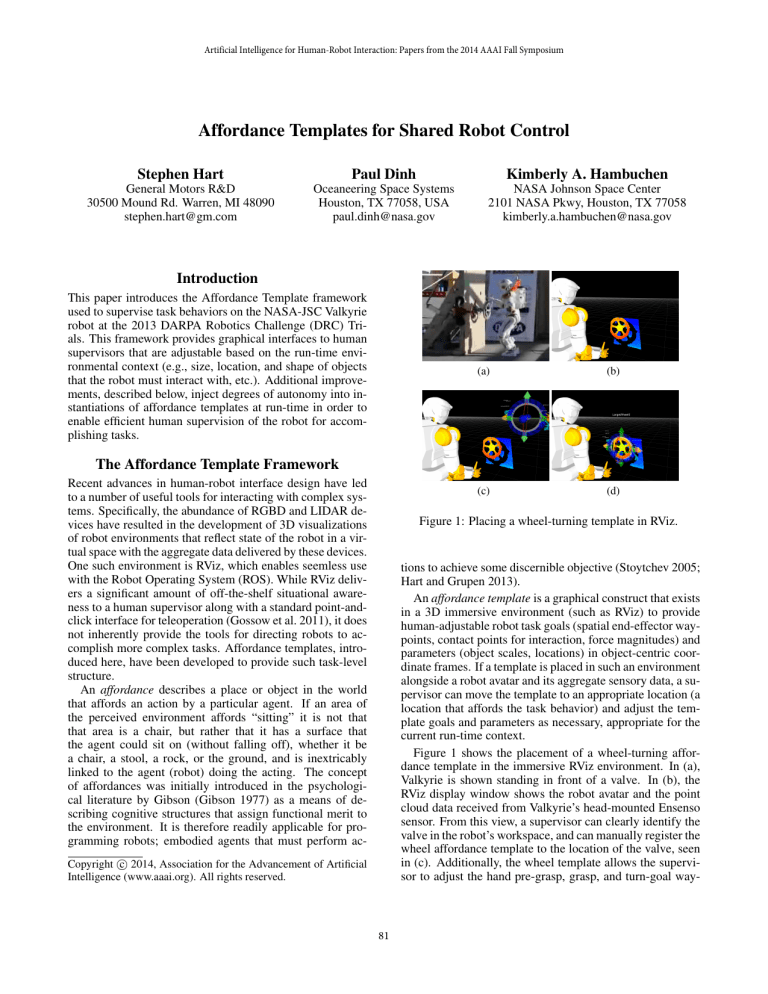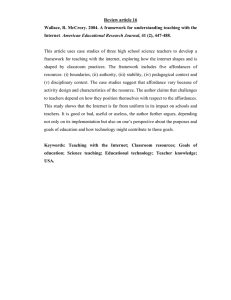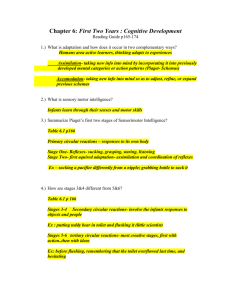
Artificial Intelligence for Human-Robot Interaction: Papers from the 2014 AAAI Fall Symposium
Affordance Templates for Shared Robot Control
Stephen Hart
Paul Dinh
Kimberly A. Hambuchen
General Motors R&D
30500 Mound Rd. Warren, MI 48090
stephen.hart@gm.com
Oceaneering Space Systems
Houston, TX 77058, USA
paul.dinh@nasa.gov
NASA Johnson Space Center
2101 NASA Pkwy, Houston, TX 77058
kimberly.a.hambuchen@nasa.gov
Introduction
This paper introduces the Affordance Template framework
used to supervise task behaviors on the NASA-JSC Valkyrie
robot at the 2013 DARPA Robotics Challenge (DRC) Trials. This framework provides graphical interfaces to human
supervisors that are adjustable based on the run-time environmental context (e.g., size, location, and shape of objects
that the robot must interact with, etc.). Additional improvements, described below, inject degrees of autonomy into instantiations of affordance templates at run-time in order to
enable efficient human supervision of the robot for accomplishing tasks.
(a)
(b)
(c)
(d)
The Affordance Template Framework
Recent advances in human-robot interface design have led
to a number of useful tools for interacting with complex systems. Specifically, the abundance of RGBD and LIDAR devices have resulted in the development of 3D visualizations
of robot environments that reflect state of the robot in a virtual space with the aggregate data delivered by these devices.
One such environment is RViz, which enables seemless use
with the Robot Operating System (ROS). While RViz delivers a significant amount of off-the-shelf situational awareness to a human supervisor along with a standard point-andclick interface for teleoperation (Gossow et al. 2011), it does
not inherently provide the tools for directing robots to accomplish more complex tasks. Affordance templates, introduced here, have been developed to provide such task-level
structure.
An affordance describes a place or object in the world
that affords an action by a particular agent. If an area of
the perceived environment affords “sitting” it is not that
that area is a chair, but rather that it has a surface that
the agent could sit on (without falling off), whether it be
a chair, a stool, a rock, or the ground, and is inextricably
linked to the agent (robot) doing the acting. The concept
of affordances was initially introduced in the psychological literature by Gibson (Gibson 1977) as a means of describing cognitive structures that assign functional merit to
the environment. It is therefore readily applicable for programming robots; embodied agents that must perform ac-
Figure 1: Placing a wheel-turning template in RViz.
tions to achieve some discernible objective (Stoytchev 2005;
Hart and Grupen 2013).
An affordance template is a graphical construct that exists
in a 3D immersive environment (such as RViz) to provide
human-adjustable robot task goals (spatial end-effector waypoints, contact points for interaction, force magnitudes) and
parameters (object scales, locations) in object-centric coordinate frames. If a template is placed in such an environment
alongside a robot avatar and its aggregate sensory data, a supervisor can move the template to an appropriate location (a
location that affords the task behavior) and adjust the template goals and parameters as necessary, appropriate for the
current run-time context.
Figure 1 shows the placement of a wheel-turning affordance template in the immersive RViz environment. In (a),
Valkyrie is shown standing in front of a valve. In (b), the
RViz display window shows the robot avatar and the point
cloud data received from Valkyrie’s head-mounted Ensenso
sensor. From this view, a supervisor can clearly identify the
valve in the robot’s workspace, and can manually register the
wheel affordance template to the location of the valve, seen
in (c). Additionally, the wheel template allows the supervisor to adjust the hand pre-grasp, grasp, and turn-goal way-
Copyright c 2014, Association for the Advancement of Artificial
Intelligence (www.aaai.org). All rights reserved.
81
• Learning: Either in the absence of, or in conjunction
with, more sophisticated planning techniques, affordance
templates could monitor the parameter values over the
course of multiple executions of a task and provide statistical feedback on whether those values are likely to lead to
task success. The metric of success could be supervised
(let the supervisor indicate task outcome after execution)
or unsupervised depending on the task’s requirements.
• Perceptual Registration: Rather than relying on the
supervisor to register templates with sensor data (as in
Figure 1), autonomous point cloud registration techniques
could be used. In fact, the robot could monitor its environment and provide “guesses” about likely affordances,
“dropping in” corresponding affordance templates with
pre-adjusted parameter settings into the virtual environment.
• Force-Based Tasks: Currently existing affordance templates only allow the supervisor to set spatial parameters
(object locations, end-effector waypoints, etc.). However,
force- or contact-based goals (apply a force along an axis
of a certain magnitude, turn the wheel with a desired
torque, etc.) could also be set in the framework. Such
specifications will ultimately be necessary for guiding a
robot to accomplish sophisticated manipulation tasks in
real world industrial or service contexts. The visualization of these parameters in a 3D spatial environment is an
interesting problem on its own terms, and currently various approaches are under investigation.
Although some of these extensions individually may require
significant research contributions, the affordance template
framework provides an efficient representation for aggregating this functionality together in a unified structure. By
keeping the supervisor “in the loop” and phasing in more autonomy as appropriate—whether in terms of planning, perception, or learning—the framework supports multiple levels of intervention that can ensure task success in multiple
contexts.
Figure 2: Turning a valve using an affordance template.
point locations (shown as different color hands, displayed
in the wheel reference frame). When the goal locations are
finalized, they can be sent to the robot’s control system to
accomplish the task (Figure 2).
Template parameters (e.g. controller reference, object
poses, navigational way-points) are meant to capture the key
degrees of freedom of the task in an efficient representation suitable for control over unreliable and/or unknown networks. It is the fact that these parameters exist, however, that
an affordance template is only a template. These parameters
must be set in order to provide sufficient information for the
task to be accomplished. As a result, affordance templates
follow a methodology of shared control, which lets the supervisor and robot control different signals simultaneously,
rather than on traded control, which assumes direct teleoperation or full autonomy. A number of affordance templates
were developed for use on the Valkyrie robot including templates for door opening, walking, hose mating, valve turning, and ladder and stair climbing.
Ongoing Work
The Affordance Template framework follows a supervisory
control paradigm of Plan, Teach, Monitor, Intervene, and
Learn (PTMIL) (Sheridan 1992). Currently, the framework
supports only the PTMI steps of this paradigm as it only
allows the supervisor to place a template in an appropriate
location, adjust certain parameters, and execute the resulting
plan to the robot (intervening if necessary). However, allowing the robot to learn from this experience is ongoing work.
Currently, the framework is being extended along multiple
dimensions.
Acknowledgments
This work was supported by the NASA/GM Robonaut 2 and
the NASA JSC DRC projects.
References
Gibson, J. J. 1977. The theory of affordances. In Perceiving, acting
and knowing: toward an ecological psychology, 67–82. Hillsdale,
NJ: Lawrence Erlbaum Associates Publishers.
Gossow, D.; Leeper, A.; Hershberger, D.; and Ciocarlie, M. T.
2011. Interactive markers: 3-D user interfaces for ros applications
[ros topics]. IEEE Robotics & Automation Magazine 18(4):14–15.
Hart, S., and Grupen, R. 2013. Intrinsically motivated affordance
discovery and modeling. In Baldassarre, G., and Mirolli, M., eds.,
Intrinsically Motivated Learning in Natural and Artificial Systems.
Springer Berlin Heidelberg. 279–300.
Sheridan, T. B. 1992. Telerobotics, Automation, and Human Supervisory Control. The MIT Press.
Stoytchev, A. 2005. Toward learning the binding affordances of objects: A behavior-grounded approach. In Proceedings of the AAAI
Spring Symposium on Developmental Robotics.
• Planning: Integration of motion planning tools such as
MoveIt! (http://moveit.ros.org) will allow extra levels of
verification, intelligence, and visualization for the supervisor concerning the robot’s expected motion for accomplishing the goal(s) of the affordance template. Moreover,
the ability to determine whether a waypoint goal is reachable after the supervisor adjusts that goal, could provide
preliminary feedback on whether the task is accomplishable in the current context. More sophisticated uses of
robot planning could also be used to eliminate the necessity for the supervisor to set all task parameters as is currently necessary, or to chain affordance templates together
to accomplish multiple extended behaviors (walk up to an
object, pick it up, use it for some purpose, etc.)
82




